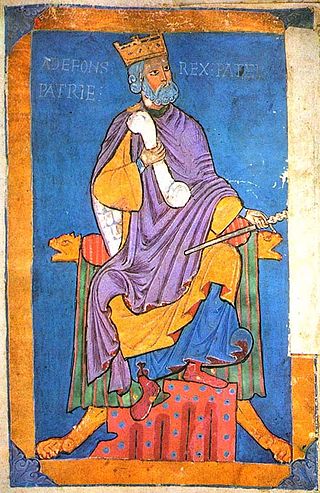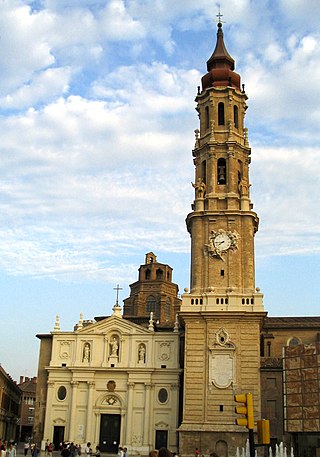Related Research Articles

Alfonso I, called the Battler or the Warrior, was King of Aragon and Navarre from 1104 until his death in 1134. He was the second son of King Sancho Ramírez and successor of his brother Peter I. With his marriage to Urraca, queen regnant of Castile, León and Galicia, in 1109, he began to use, with some justification, the grandiose title Emperor of Spain, formerly employed by his father-in-law, Alfonso VI. Alfonso the Battler earned his sobriquet in the Reconquista. He won his greatest military successes in the middle Ebro, where he conquered Zaragoza in 1118 and took Ejea, Tudela, Calatayud, Borja, Tarazona, Daroca, and Monreal del Campo. He died in September 1134 after an unsuccessful battle with the Muslims at the Battle of Fraga.

Rodrigo Díaz de Vivar was a Castilian knight and ruler in medieval Spain. Fighting both with Christian and Muslim armies during his lifetime, he earned the Arabic honorific as-Sayyid, which would evolve into El Çid, and the Spanish honorific El Campeador. He was born in Vivar, a village near the city of Burgos.

Alfonso VI, nicknamed the Brave or the Valiant, was king of León (1065–1109), Galicia (1071–1109), and Castile (1072–1109).

Alfonso, Duke of Anjou, Duke of Cádiz, Grandee of Spain was a grandson of King Alfonso XIII of Spain, a potential heir to the throne in the event of the restoration of the Spanish monarchy, and the Legitimist claimant to the throne of France.

The Abravanel family, also spelled as Abarbanel, Abrabanel, Avravanel, Barbernell, or Barbanel – literally meaning Ab ("father") rabban ("priest") el – is one of the oldest and most distinguished Jewish families. It first achieved prominence on the Iberian Peninsula during the Middle Ages. Its members claim to trace their origin to the biblical King David. Members of this family lived in Seville, Córdoba, Castile-Leon, and Calatayud. Seville is where its most prominent representative, Don Judah Abravanel, once dwelt.

Spain in the Middle Ages is a period in the history of Spain that began in the 5th century following the fall of the Western Roman Empire and ended with the beginning of the early modern period in 1492.

García Ramírez, sometimes García IV, V, VI or VII, called the Restorer, was the King of Navarre (Pamplona) from 1134. The election of García Ramírez restored the independence of the Navarrese kingdom after 58 years of political union with the Kingdom of Aragon. After some initial conflict he would align himself with king Alfonso VII of León and Castile, and as his ally take part in the Reconquista.
The Zóbel de Ayala clan is a prominent Filipino family of Spanish and German descent who were the founders of Ayala y Compañía and patrons of the Premio Zóbel literary awards. The clan is directly descended from Jacobo Zóbel y Zangroniz (1842–1896) and Trinidad de Ayala (1856–1918). Ayala y Compañía traces its origins to Casa Róxas, a business partnership established in 1834 between Domingo Róxas (1792–1843) and Antonio de Ayala (1803–1876).

The Archdiocese of Saragossa is a Latin diocese of the Catholic Church located in north-eastern Spain, in the province of Zaragoza, part of the autonomous community of Aragón. The archdiocese heads the ecclesiastical province of Saragossa, having metropolitan authority over the suffragan dioceses of Barbastro-Monzón, Huesca, Tarazona, and Teruel and Albarracín.

The Diocese of Tarazona is a Latin diocese of the Catholic Church located in north-eastern Spain, in the provinces of Zaragoza, Soria, Navarre and La Rioja, forming part of the autonomous communities of Aragón, Castile-Leon, Navarre and La Rioja. The diocese forms part of the ecclesiastical province of Zaragoza, and is thus suffragan to the Archdiocese of Zaragoza.

The Diocese of Segorbe-Castellón is a Latin Church diocese of the Catholic Church located in north-eastern Spain, in the province of Castellón, part of the autonomous community of Valencia. The diocese forms part of the ecclesiastical province of Valencia, and is thus suffragan to the Archdiocese of Valencia.
Alonso de Estrada was a colonial official in New Spain during the period of Hernán Cortés' government, and before the appointment of the first viceroy. He was a member of the triumvirates that governed the colony for several short periods between 1524 and 1528, in the absence of Cortés.

Alcañiz is a town and municipality of Teruel province in the autonomous community of Aragon, Spain. The town is located on the banks of the river Guadalope. Alcañiz is the unofficial capital of the Lower Aragon historical region. It lies some 113 km (70 mi) from Teruel, the provincial capital, and 92 km (57 mi) from Zaragoza, the capital of Aragon.
De la Caballeria , was a Sephardic family of Aragon, Spain, widely ramified, and influential through its wealth and scholarship, especially in Saragossa. The family descended from Solomon ibn Labi de la Caballeria, who had nine sons.

Paul of Burgos was a Spanish Jew who converted to Christianity, and became an archbishop, lord chancellor, and exegete. He is known also as Pablo de Santa María. His original name was Solomon ha-Levi.
Pedro Ruiz de Azagra was a Navarrese nobleman and soldier who established the independent Lordship of Albarracín, which lasted until 1284. He was the second son of Rodrigo Pérez de Azagra. His elder brother was Gonzalo Ruiz and his younger brother, later successor, was Fernán Ruiz.
Luis de Requesens y de Relat was Catalan baron of Altafulla, baron of La Nou de Gaià, both in the province of Tarragona, Spain.
Pedro Ponce de León the Elder was a Castilian nobleman, great-grandson of King Alfonso IX of León. He was a knight of the Order of the Band, and Lord of Marchena, Bailén, Rota, Mairena del Alcor, Bornos and Oliva de la Frontera.

Sancho Sánchez was an important magnate of the Kingdom of Aragon in the late 11th and early 12th centuries, during the reigns of Sancho Ramírez, Peter I and Alfonso I. He was governor of the important Navarrese tenancies of Erro, the castle of San Esteban de Deyo (1084), the capital city of Pamplona (1092), Aibar and Tafalla (1098) and Falces and Leguín (1112). In Aragon proper, he governed the important fortress of El Castellar overlooking Muslim Zaragoza from 1091 and the town of Ejea from 1113. He held the rank of count from 1085, before that he was a lord (senior).
Jaime de Montesa, was a Spanish jurist and the highest authority of Zaragoza until 1485.
References
 This article incorporates text from a publication now in the public domain : Gottheil, Richard; Kayserling, Meyer (1902). "Caballeria, Bonafos (סופנוב) de la". In Singer, Isidore; et al. (eds.). The Jewish Encyclopedia . Vol. 3. New York: Funk & Wagnalls. p. 480.
This article incorporates text from a publication now in the public domain : Gottheil, Richard; Kayserling, Meyer (1902). "Caballeria, Bonafos (סופנוב) de la". In Singer, Isidore; et al. (eds.). The Jewish Encyclopedia . Vol. 3. New York: Funk & Wagnalls. p. 480.